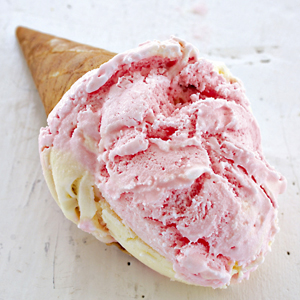Homemade ice cream (whether it’s made with cream or egg yolk and
cream) is always a show-piece. A classic egg custard ice cream consists
of 500ml milk, 135g sugar, 6-8 egg yolks and 250ml cream churned in an
ice cream maker until smooth as silk. Some experts choose to cook the
cream with the milk, as a custard, while others prefer the lightness of
it whipped and stirred in afterwards. Mixtures made with fresh, raw
fruit pureé may be thickened with gelatin. These pureés should be thick
and concentrated and keep in mind that fruits containing too much acid
may curdle the egg custard. For this reason only the rind of orange and
lemon should be used in a citrus ice cream, and fruits such as plums
must be cooked before they are pureéd and added to the mixture.
The mixture should be churned until really smooth before frozen,
otherwise lumps will form. Traditionally, sorbets and ice creams are
made with ice cream machines, but using a food processor (or blender)
and freezing the product in airtight plastic storage containers
produces just as good results, without the fuss. If your ice cream has
a granular texture, it may be because you used too much water or
alcohol or too little sugar and fat. Also bear in mind that taste is
blunted by extreme cold, so you’ll need to use concentrated flavours as
well as plenty of sugar to keep it alive.
A sorbet
is easy to make and basically consists of sugar or a sugar syrup (2/3
cup granulated sugar to 1/2 cup water for 1 cup sorbet) and flavouring,
mixed then frozen. The general method for making a sorbet involves
pureeing fruit pulp and combining it with the simple sugar syrup. This
can be any kind of fresh fruit, especially overripe fruit. Try mangoes,
strawberries, kiwis, peaches, payapya, pears, plums or sweet melon.
Place
about 4 cups ripe fresh fruit, peeled, pitted and coursely chopped,
with 1tbsp fresh lemon or lime juice in a food processor and proeces
until smooth. Gradually add the sugar syrup and process to blend evenly.
Taste for sweetness and if the sorbet needs more syrup pour in littly
by little and process again. Transfer to a medium-sized metal bowl or
cake pan, cover with plastic wrap and place in the freezer. Allow to
partially freeze for about four hours; ice will form around th edge, but
the centre will be mushy. If the mixture freezes solid, let it
partially thaw at room remperature before proceeding. Return the
mixture to the food processor and reprocess until completely blended,
smooth and fluffy (about one minute). Immediately scrape the mixture
into a plastic freezer container with an airtight lid an refreeze for
4- 10 hours. Allow to soften at room tempreature for about 15 minutes
before serving.
Remember, as a general rule of thumb, the less
syrup used, the icier the texture. Sorbets are best served the day
they’re made as flavours tend to weaken and the texure becomes grainy
after about 24 hours. The taste can be intensified by adding a liqueur
or Kirsch, chopped herbs such as mint, or spices such as cinnamon. The
texture can be lightened by adding whipped egg whites or broken up
Italian merinques, halfway through churning.
Sherbet is made by substituting the sorbet’s water with milk and thoroughly whipping the mixture together
Ice cream as we know now, is frozen cream or egg yolk-and-cream custard.
Granita is water ice in which the coarse texture of large ice crystals is preserved.
Gelato is silky-textured ice cream made with milk and enriched with egg yolks, chocolate, nuts, coffee, dried fruit or liquor.
Semifreddo is a gelato base folded into whipped cream and then chilled, without being churned or frozen.
Affagato is ice cream drowned with a shot of espresso or whisky.
Did you know?
# The very first ice treats were created by the Greeks and Romans who chilled their wine with mountain snow to make a refreshing, lightly alcoholic slush.
# The Florentines and Venetians have been making superb ice creams for centuries, but the finest in the world is the smooth, rich almond and pistachio gelato made in Sicily.
# When making ice cream (except softies like semifreddo), it’s necessary to beat it several times during the freezing process to prevent ice crystals forming.
# Pureed fresh pears or green apples enhance the texture of ice cream.
# Black peppercorns boost the flavour of ice cream.
# Russians eat ice cream in winter to keep warm (much as the Indians drink hot tea in summer to cool down).
# Vanilla is in short supply because it’s still the world’s most popular ice-cream flavour.
5 things to do with ice cream
Apricot ice cream bars

